HOME SCIENCE
Paper – II
Note : This paper contains fifty (50) objective type questions of two (2) marks each. All questions are compulsory.
1. RDA of thiamin (ICMR, 2010) for a moderately active man is
(1) 1.2 mg/day
(2) 1.4 mg/day
(3) 1.5 mg/day
(4) 1.7 mg/day
2. ‘Allin’ is a compound found in
(1) Garlic
(2) Turmeric
(3) Cinnamon
(4) Cloves
3. Which is the correct danger zone in food production ?
(1) 45° F – 115° F
(2) 41° F – 135° F
(3) 35° F – 120° F
(4) 38°F – 145° F
4. Which of the following is the theory of clothing ?
(1) Individuality
(2) Conformity
(3) Tattooing
(4) Modesty
5. Denier is the weight in gms of :
(1) 9000 metres of yarn
(2) 1000 metres of yarn
(3) 560 metres of yarn
(4) 840 metres of yarn
6. Which of the following is concerned with the functions of management ?
(1) Henri Fayol
(2) Taylor
(3) Gilbreth
(4) Elton Mayo
7. Participant observation of a culture or a distinct social group where a researcher tries to understand the cultures’ values and social processes is called
(1) Experimental observation
(2) Ethnography
(3) Clinical method
(4) Structured observation
8. Who was the initiator of the ‘Gurgaon Experiment’ under Rural Reconstruction ?
(1) Rabindranath Tagore
(2) F.L. Brayne
(3) Daniel Hamilton
(4) Malcom Marshall
9. As per the Aristotle’s model of communication, the three dimensions of persuasive speech are
(1) Ethos, Empathy, Mathos
(2) Ethos, Logos, Pathos
(3) Empathy, Chaos, Pathos
(4) Logos, Ethos, Laos
10. In Symmetrical or Normal Distribution
(1) Median is greater than Mean and Mode.
(2) Mean, Median and Mode have the same value.
(3) Mean is greater than Median and Mode.
(4) Mode is greater than Mean and Median.
11. Following are the symptoms of ascorbic acid deficiency :
I. Symmetrical Dermatitis
II. Gingivitis
III. Oedema
IV. Delayed wound healing
V. Petechiae haemorrhage
Codes :
(1) I, II and IV
(2) II, IV and V
(3) II, III and IV
(4) II, III and V
12. Following are the factors that inhibit iron absorption in the body :
I. Low gastric acidity
II. Ascorbic acids
III. Animal proteins
IV. Phytic acid
V. Tannins
Codes :
(1) I, IV and V
(2) I, II and IV
(3) I, III and V
(4) I, II and III
13. Methods used for assessing performance are
I. Chronocycle-graph
II. Work sampling
III. Pathway Chart
IV. PERT
V. HACCP
VI. Micro motion
Codes :
(1) I, II, III, VI
(2) II, III, IV, V
(3) III, IV, II, I
(4) IV, V, VI, I
14. Which of the following can be used to remove the grease stain ?
I. Fuller’s Earth
II. Benzene
III. Glycerine
IV. Vinegar
Codes :
(1) II and III
(2) I and II
(3) III and IV
(4) I and IV
15. Which of the following fibers have good resiliency ?
I. Wool
II. Polyester
III. Rayon
IV. Cotton
Codes :
(1) I, III
(2) III, IV
(3) I, II
(4) I, IV
16. Which of the following are the types of human resources ?
I. Knowledge
II. Bank
III. Attitude
IV. Intelligence
V. Soil
Codes :
(1) I, II, IV
(2) I, III, IV
(3) II, IV, V
(4) III, IV, V
17. The following are milestones of emotional development during infancy :
I. Separation anxiety
II. Social smile
III. Strange anxiety
IV. Altruistic behaviour
Codes :
(1) I, II, III
(2) I, III, IV
(3) II, III, IV
(4) I, II, IV
18. The qualities of a receiver, which influence face to face communication are :
I. Positive attitude
II. Active Listening skills
III. Channel vehicle
IV. Decoding skills
Codes :
(1) I, II and III
(2) II, III and IV
(3) I, II and IV
(4) I, III and IV
19. Which of the following approaches indicate the methodology of Extension Education ?
I. Simple to Complex
II. Concrete to Abstract
III. Learning by doing
IV. Learning by listening
Codes :
(1) I, II and III
(2) II, III and IV
(3) I, III and IV
(4) II, IV and I
20. In a Random Sampling distribution of means :
I. The standard error will decrease as the sample size increases.
II. The standard error will increase as the sample size increases.
III. The mean equals the population mean.
IV. The mean is not equal to the population mean.
Codes :
(1) I and III
(2) II and IV
(3) I and IV
(4) II and III
21. Assertion (A) : Complex carbohydrates are recommended in diabetic diets.
Reason (R) : The complex carbohydrates have a low Glycemic Index.
Codes :
(1) Both (A) and (R) are correct.
(2) (A) is correct and (R) is incorrect.
(3) (A) is incorrect and (R) is correct.
(4) Both (A) and (R) are incorrect.
22. Assertion (A) : Addition of soda-bi-carbonate during cooking of green vegetables makes them bright green.
Reason (R) : The pigment chlorophyll changes to pheophytins in alkaline medium.
Codes :
(1) Both (A) and (R) are correct.
(2) (A) is correct and (R) is incorrect.
(3) (A) is incorrect and (R) is correct.
(4) Both (A) and (R) are incorrect.
23. Assertion (A) : A cycle menu is a selective menu.
Reason (R) : It is rotated at definite intervals.
Codes :
(1) Both (A) and (R) are correct.
(2) (A) is incorrect and (R) is correct.
(3) (A) is correct and (R) is incorrect.
(4) Both (A) and (R) are incorrect.
24. Assertion (A) : Collars, seams and texture when put together create structural design.
Reason (R) : Structural design is inherent parts of the garment.
Codes :
(1) (A) is correct but (R) is incorrect.
(2) (A) is incorrect but (R) is correct.
(3) Both (A) and (R) are correct and (R) is the correct explanation of (A).
(4) Both (A) and (R) are correct, but (R) is not the correct explanation of (A).
25. Assertion (A) : Microscopic test is a confirmatory test for man-made fibres.
Reason (R) : Man-made fibres have their distinct characteristic microscopic appearance.
Codes :
(1) Both (A) and (R) are correct.
(2) Both (A) and (R) are incorrect.
(3) (A) is correct, but (R) is incorrect.
(4) (A) is incorrect, but (R) is correct.
26. Assertion (A) : Indirect light is ideal for general illumination.
Reason (R) : This light is directed to a ceiling from where it is reflected back into the room.
Codes :
(1) Both (A) and (R) are correct.
(2) (A) is correct, but (R) is incorrect.
(3) (A) is incorrect, but (R) is correct.
(4) Both (A) and (R) are incorrect.
27. Assertion (A) : For Piaget the most serious deficiency of pre-operational thinking is egocentrism and underlies all others.
Reason (R) : Young children ego-centrically assign human purposes to physical events and magical thinking is common.
Codes :
(1) Both (A) and (R) are incorrect.
(2) Both (A) and (R) are correct.
(3) (A) is correct, but (R) is incorrect.
(4) (A) is incorrect, but (R) is correct.
28. Assertion (A) : Mass communication is a transactional process.
Reason (R) : In most of the mass communication situations, the communicator and the audience are in asynchronous relationship.
Codes :
(1) (A) is correct, (R) is incorrect.
(2) (A) is incorrect, (R) is correct.
(3) Both (A) and (R) are correct.
(4) Both (A) and (R) are incorrect.
29. Assertion (A) : Result demonstration refers to the showing net worth of a practice or a product.
Reason (R) : Result demonstrations do not only establish the value of a practice but also prove the feasibility of the practice under local conditions.
Codes :
(1) (A) is correct and (R) is incorrect.
(2) (A) is incorrect and (R) is correct.
(3) Both (A) and (R) are correct.
(4) Both (A) and (R) are incorrect.
30. Assertion (A) : The power of a statistical test is the probability, given that null hypothesis is false, of obtaining sample results that will lead to its rejection.
Reason (R) : The larger the sample size, the greater is the power of the statistical test.
Codes :
(1) Both (A) and (R) are correct.
(2) Both (A) and (R) are incorrect.
(3) (A) is correct, and (R) is incorrect.
(4) (A) is incorrect and (R) is correct.
31. Arrange the steps involved in conducting 24 hour dietary recall in correct sequence :
I. Convert the amount of food & beverages consumed into amounts of raw foods.
II. Standardize the recipes.
III. Preparation and pretesting of questionnaire.
IV. Compare energy and nutrient intake with RDA.
V. Collect information on all foods and beverages eaten by respondent in previous 24 hours using standardized equipment.
VI. Calculate energy and nutrients using food composition tables.
Codes :
(1) II, V, III, I, VI, IV
(2) V, II, III, I, VI, IV
(3) III, V, II, I, VI, IV
(4) III, V, I, II, IV, VI
32. Arrange the steps of processing of wheat in the correct sequence :
I. Purifying II. Washing
III. Aspirating IV. Bleaching
V. Grinding VI. Tempering
Codes :
(1) I, II, V, III, IV, VI
(2) II, I, IV, III, V, VI
(3) III, II, VI, V, I, IV
(4) I, III, VI, II, IV, V
33. Write in the right sequence the steps taken in an orientation program :
I. Introduction to facilities
II. Introduction to job
III. Review of company policies & practice
IV. Breaking Ice
V. Introduction to fellow workers
VI. Setting Employees expectation
Codes :
(1) III, VI, I, II, V, IV
(2) IV, III, VI, V, I, II
(3) I, II, III, VI, V, IV
(4) II, IV, VI, I, V, III
34. Give the correct path of the upper thread in the sewing machine :
I. Tension discs II. Needle
III. Spool IV. Thread guide
V. Thread take up lever
Codes :
(1) II, III, IV, V, I
(2) I, III, II, V, IV
(3) III, IV, I, V, II
(4) IV, II, III, I, V
35. Give the correct sequence of making woollen felts :
I. Layering of wool fibers
II. Cleaning, blending and carding of wool fibres
III. Beating, compressing and squeezing the web
IV. Application of heat and moisture
V. Imparting required finish to the felt
VI. Scouring, rinsing and drying
Codes :
(1) I, II, III, IV, VI, V
(2) II, I, IV, III, V, VI
(3) III, IV, II, I, V, VI
(4) II, I, IV, III, VI, V
36. Arrange in correct sequence the steps involved in decision-making :
I. Selecting the best alternative
II. Identifying the problem
III. Searching alternative solutions
IV. Thinking through alternatives
V. Feedback
Codes :
(1) I, III, II, V, IV
(2) V, III, I, II, IV
(3) II, III, IV, I, V
(4) III, V, I, IV, II
37. Arrange according to the stages of child birth :
I. Placenta delivery
II. Transition
III. Dilation and effacement of cervix
IV. Pushing
V. Birth of baby
Codes :
(1) II, III, IV, V, I
(2) III, II, IV, V, I
(3) III, IV, II, V, I
(4) IV, III, II, V, I
38. Arrange the steps of Extension Campaign Planning in their sequential order :
I. Draw a concrete plan
II. Identify the local needs
III. Arrange for supplies and support
IV. Choose the Appropriate Methods and Media
V. Decide the dates and time
Codes :
(1) II, III, IV, V, I
(2) II, III, IV, I, V
(3) II, III, I, V, IV
(4) II, III, I, IV, V
39. Arrange the following stages of ‘Coming Together’ in developing relationships through communication as presented by Mark Knapp :
I. Experimenting II. Bonding
III. Integrating IV. Initiating
V. Intensifying
Codes :
(1) I, IV, II, III, V
(2) II, III, IV, V, I
(3) III, II, IV, I, V
(4) IV, I, V, III, II
40. Arrange the steps in the construction of grouped data frequency distribution in correct sequence :
I. Find the range
II. Determine the point at which lowest interval should begin.
III. Divide the range by 10 and by 20 to determine acceptable and convenient interval width.
IV. Enter the frequency of raw scores in appropriate class interval.
V. Record limits of all class intervals, placing the highest score class interval at top.
VI. Find the value of the lowest and the highest score.
Codes :
(1) VI, II, I, III, IV, V
(2) VI, I, II, III, IV, V
(3) VI, I, III, II, V, IV
(4) VI, II, I, III, V, IV
41. Match the nutrients in List – I with their deficiency symptoms with List – II :

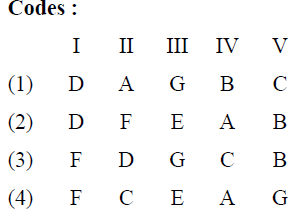
42. Match the laboratory tests given in List – I with their chemical compound given in List – II :
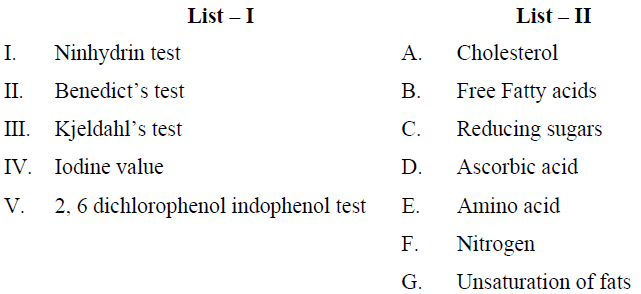
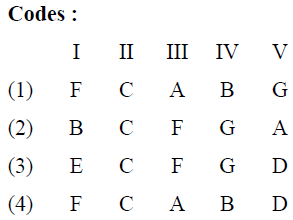
43. Match the given names in List – I with Theories of Management in List – II :
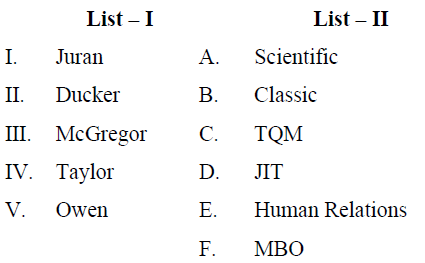

44. Match the terms given in List – I with their description given in List – II :
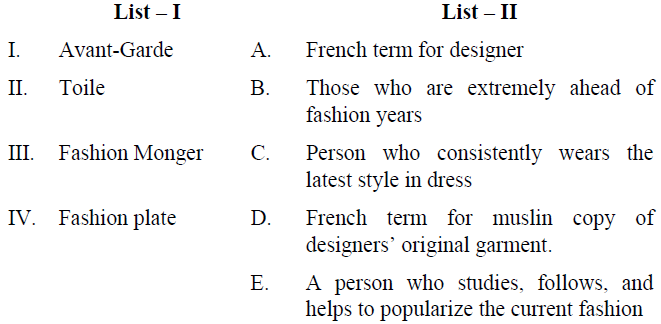
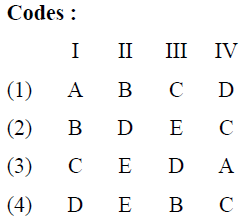
45. Match the items given in List – I with the items given in List – II :
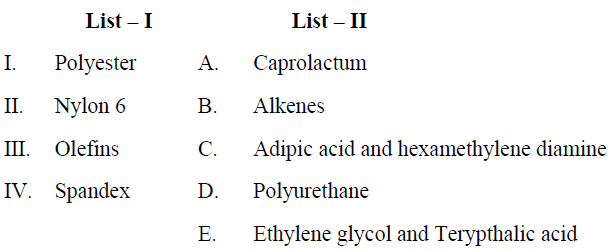
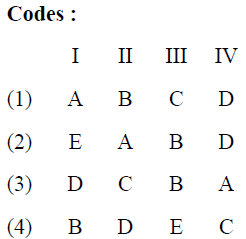
46. Match the items given under List – I with the appropriate items under List – II :

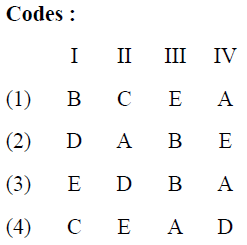
47. Match the concepts in List – I with their characteristics in List – II :
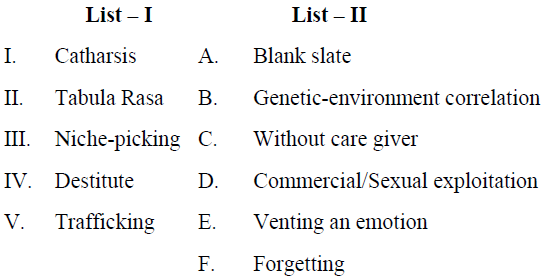
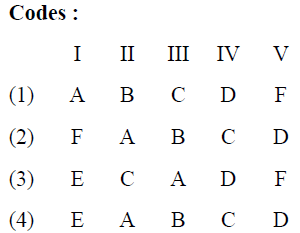
48. Match the programmes given in List – I with the year of their inception given in List – II :
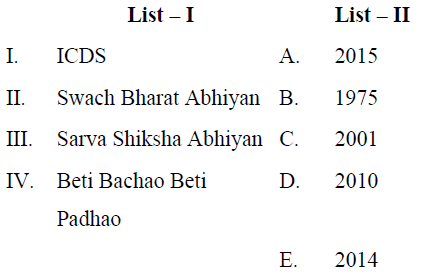
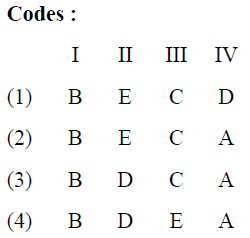
49. Match the functions of communication given in List – I with their related activities given in List – II :
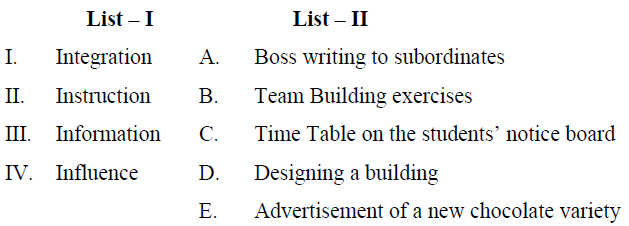
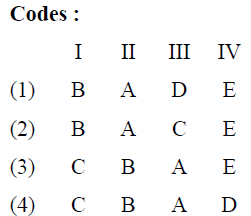
50. Match the items in List – I with items in List – II :
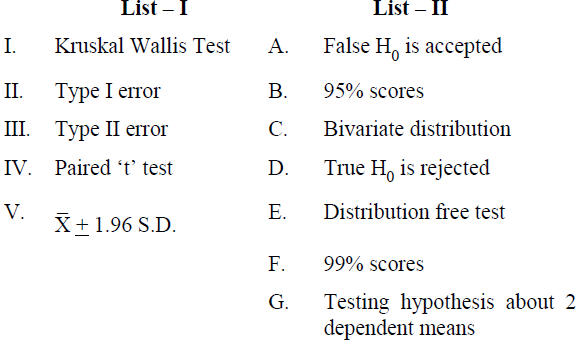
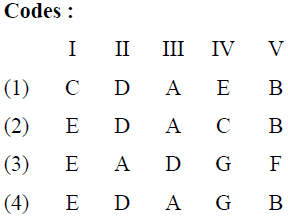
Latest Govt Job & Exam Updates: